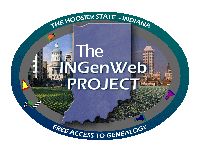MILL Creek Township-1887
Mill Creek Township
977. 249D3b
Biographical and Historical Record of Putnam County, Indiana.
Chicago: Lewis Publishing Company, 1887, p. 230-231
The first settler in this township was Thomas Broadstreet, Sr. , who was born in Virginia in the year 1813. In the year 1826, at the age of thirteen, he came West with his father, who settled within one mile of the west edge of the township. Although but a boy at that time, he was acquainted with nearly all the early settlers of the township. The first log cabin in Mill Creek Township was built in the year 1826, on the west bank of the stream from which the township takes its name, one and a half miles south of Stilesville, by Jacob Holmes. This house was afterward sold to James Sallust. The next was built on what is known as the Clark farm, by Thomas Skelton. William Parker entered land and built a house close by, and then came Elisha Hurst and Norman Nunn. They were all early settlers, and owned land adjoining the Clark farm on the west. William Heavin came here in the year 1827, and at first built a log cabin, but within a few years erected a good hewed-log house. At a very early day, Mr. Heavin built a water-mill of the kind known to old settlers as a hominy-pestle; and he also planted the first orchard in the township.
The first death which occurred in the township was that of Mrs. Barbara Heavin, wife of William Heavin, who died in the year 1830, and was interred near the family dwelling. After eight years more of toil in this new country, her husband followed her in death, and was laid beside the remains of his companion.
In the year 1828, the one following that which marked the arrival of Mr. Heavin, Daniel McAninch settled in Mill Creek Township.
James Sallust, father of John and William Sallust of this township and of J. R. Sallust of Oregon, came from Virginia to Mill Creek in the year 1829, and lived in his traveling-tent until he built a cabin in which to live. It is remarked of Mr. Sallust that he was a man of great industry, and he put under cultivation a large part of the farm on which his son John Sallust is now living. Mr. Sallust made the first kiln of brick in the township. His molder and burner was a man named Daniel Elliott. Mr. Sallust lived to the year 1851. Mr. McHaffie, from Knox County, Pennsylvania, father of M. F. McHaffie, bought land in the north part of the township in the year 1831, to which he removed in the fall of the next year. He built the first water-power grist mill in the township in the years 1835-'36. Samuel Beadie, Pleasant Allee and William Allee all came to the township in the year 1837.
The first child born in the township was Nancy E. Holmes, daughter of Jacob Holmes, who built the first house in the township. Her birth occurred May 7, 1830. This child died at the age of four years. The first marriage was that of Eli Lee and Polly Heavin, daughter of William and Barbara Heavin, in the year 1832. Mr. Lee built the first horse-mill, which was one widely known and extensively patronized for many years. The first school-house in this township was built on the farm of a Mr. Bricks. The puncheons for the floor and seats of this house were hewed by Pleasant Allee.
The Methodist church was organized in the township in the year 1829, at the house of Mr. Bricks, mentioned above. Services were afterward held at the school house until the erection of Mount Pisgah Church, on the land of Norman Nunn, in the year 1844 or 1845. Mr. Thomas Broadstreet was one of the earliest if not the first minister in the township.
Thomas Elliott improved the place at the forks of the Greencastle and National roads, where he first built a log house, in which he kept tavern, as did also Mr. Keller, just across the line in Hendricks County. In the year 1837 Mr Elliott built a brick house, and, in the following year, Mr. Keller built a two-story frame. These were rival houses, and attained to great notoriety. They were known as the "Indian Chief" Tecumseh and "Washington Hall". They were together called "the twin taverns".
While the National Road was constructing, in the years 1833 and 1834, the General Government built two bridges over small creeks just west of the twin taverns, the stone abutments of which are good to this day. This is true also of other works of the same kind constructed on that road at the same date.

